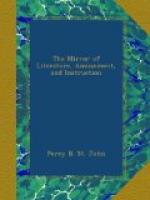(For the Mirror.)
Sir Walter Scott, in his history of Demonology and Witchcraft, has omitted a tradition which is still popular in Cheshire, and which from its close resemblance to one of the Scottish legends related by that writer, gives rise to many interesting conjectures respecting the probable causes of such a superstition being believed in countries with apparently so little connexion or intercourse, as Cheshire and Scotland. The facts of Sir Walter’s narration are as follow: vide Demonology and Witchcraft, p. 133.
“A daring horse jockey having sold a horse to a man of venerable and antique appearance, had a remarkable hillock on the Eildon Hills, called Lucken Hare, appointed as the place where, at twelve o’clock at night, he should receive the price. He came, the money was paid in an ancient coin, and he was invited by the purchaser to view his residence. The trader followed his guide through several long ranges of stalls, in each of which a horse stood motionless, while an armed warrior lay equally still at his charger’s feet. ‘All these men,’ said the wizard in a whisper, ‘will awaken at the battle of Sheriffmoor.’ A horn and a sword hung suspended together at one extremity of the chamber. The former the jockey seized, and having sounded it, the horses stamped, the men arose and clashed their armour; while a voice like that of a giant pronounced these words:—
“Woe to the coward that ever he
was born,
Who did not draw the sword before he blew
the horn.”
Subsequent to this, Sir Walter proceeds to the relation of another kindred tradition, the incidents of which do not materially differ from those of the preceding. The scene of the Cheshire legend is placed in the neighbourhood of Macclesfield, in that county, and the sign of a public-house on Monk’s Heath may have arrested the attention of many travellers from London to Liverpool. This village hostel is known by the designation of the Iron Gates. The sign represents a pair of ponderous gates of that metal, opening at the bidding of a figure, enveloped in a cowl; before whom kneels another, more resembling a modern yeoman than one of the 12th or 13th century, to which period this legend is attributed. Behind this person is a white horse rearing, and in the back ground a view of Alderley Edge. The story is thus told of the tradition to which the sign relates:
The Iron Gates, or the Cheshire Enchanter.
A farmer from Mobberley was riding on a white horse over the heath, which skirts Alderley Edge. Of the good qualities of his steed he was justly proud; and while stooping down to adjust its mane, previously to his offering it for sale at Macclesfield, he was surprised by the sudden starting of the animal. On looking up he perceived a figure of more than common height, enveloped in a cowl, and extending a staff of black wood across his path. The figure addressed him in a commanding voice; told him that he would




